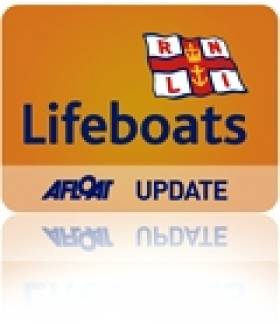Displaying items by tag: Courtmacsherry RNLI
Courtmacsherry RNLI Lifeboat in Dog Rescue from Harbour
A dog that had been reported missing for several hours in West Cork was rescued by the Courtmacsherry RNLI Lifeboat Station on Wednesday afternoon. The station received a call from two people on the shore who had spotted the dog in grave danger of being washed away on a sandbank off Burren Rock in Courtmacsherry Bay. The lifeboat pagers were immediately activated by Lifeboat Operations Manager Brian O'Dwyer.
Within minutes, the Rigid Inflatable Station House Boat was launched with Station Coxswains Ken Cashman and Mark John Gannon on board. The crewmembers responded quickly to the callout and were able to reach the dog, which was struggling in the strong currents. With the assistance of local man Dave Edwards in another small craft, the Lifeboat Crew were able to coax the dog towards the Lifeboat and finally crewman Mark John was able to catch the shocked dog and bring him to the safety of the Lifeboat.
The Lifeboat very quickly returned to the Lifeboat Slipway, where crew members assisted with the safe landing of dog Bonnie on dry land. Shortly after the rescue, the owners of Bonnie arrived as they had been looking for their precious Sheepdog for many hours, as he had been frightened by other dogs in the locality around mid-day. The relieved owners were reunited with Bonnie and were highly praised for the great work done so quickly by the lifeboat crew.
The Courtmacsherry Lifeboat Launch Authority and press officer Vincent O Donovan praised the two concerned ladies on the shore who alerted the authorities immediately when they spotted the dog in difficulty. He also gave credit to the fast response of the Lifeboat Crew, which ensured that Dog Bonnie was reached before being taken out to sea. Vincent added, “it was so great to see the joy on the owner's faces on being reunited with Bonnie and thus a very happy ending for all concerned”.
Pleasure Boat Rescue By RNLI Courtmacsherry
The Courtmacsherry RNLI All Weather Lifeboat was called out at 12.16pm this afternoon to go to the aid of a 17–foot pleasure boat that got into difficulties off Coolmain, east of the Old Head of Kinsale in West Cork.
The Courtmacsherry Lifeboat under Coxswain Sean O'Farrell and a crew of six launched immediately and reached the stricken causality within 15 minutes. The pleasure boat, with six persons on board had encountered engine difficulties and was blown onshore at the coastline called Nuns Cove.
On scene, the Lifeboat assessed the difficulties with the casualty and two lifeboat crew members Ciaran Hurley and Dean Hennessey used the Trent Lifeboat's X Boat to access the shoreline and secure a tow line to the stricken vessel.
The Lifeboat then proceeded to tow the boat away from the shoreline and subsequently brought them back to the safe haven of Courtmacsherry Harbour.
Conditions at sea today were blustery with Winds in the area blowing force 4/5 but rising from early afternoon.
The Crew on board today's callout were Coxswain Sean O'Farrell and crew members Stuart Russell, Denis Murphy, Mark John Gannon, Dean Hennessy and the father and son combination of Micheal and Ciaran Hurley.
Courtmacsherry RNLI Lifeboat Station LPO Brian O Dwyer commented, " We are pleased that our Lifeboat was again fast away today with our ever ready volunteers always available and that the rescue was carried out with great skill and precision on a dangerous coastline in today's winds".
Lifeboat Tows Yacht to Safety in West Cork
Breaking News reports that the Courtmacsherry RNLI Lifeboat towed a yacht to safety yesterday afternoon after it got into difficulties in poor weather.
The lifeboat was called out at 1.15pm to the 37ft yacht, with three people on board, in Clonakilty Bay in West Cork.
The boat was subsequently towed to the Blind Strand in Courtmacsherry Bay and assessed for damage. No injuries have been reported.






























































